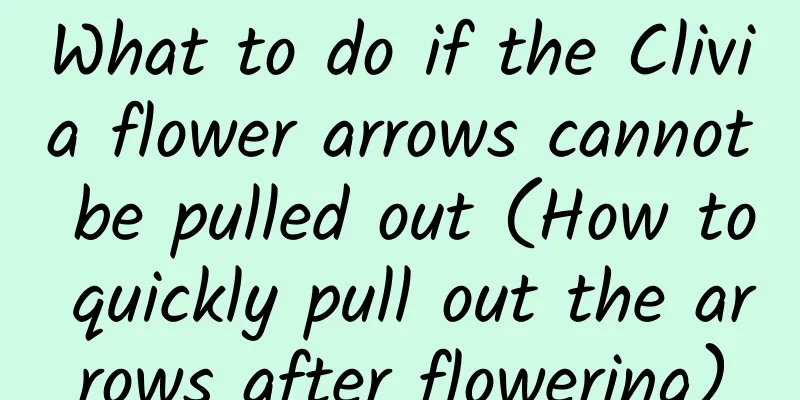What to do if the Clivia flower arrows cannot be pulled out (How to quickly pull out the arrows after flowering)

There are several reasons why Clivia is slow to pull out its arrows.The most common problem is pruning the Clivia. The flower arrow is only half grown, or it gets stuck between the leaves and cannot grow out as soon as it grows out. This situation is what we call pruning. During the maintenance process, the real problem of flower arrow stuck is that the flower arrow of Clivia cannot be pulled out and is stuck between the leaf centers. Moreover, the flower arrow has slowly bloomed after it cannot be pulled out. In fact, the biggest reason is insufficient nutrition, and there is not enough nutrition to meet the needs of pulling out the arrow . If the Clivia grows poorly and is undernourished, it will be unable to pull out the arrows, and it will be difficult to bolt and bloom. Therefore, when raising Clivia, you should pay attention to the supply of nutrients. Let's take a closer look at the reasons and treatment methods for the Clivia flower arrows that cannot be pulled out. (1) Insufficient growth years:It takes about 5 to 6 years for Clivia to grow from a seedling to the flowering stage, and it is mature when the leaves reach at least 6 pairs. Sufficient growth years and more than 6 pairs of leaves are the first prerequisites for Clivia to bloom. As long as the Clivia is growing healthily, you should consider whether it is due to insufficient growth years. Do not give Clivia drugs to promote flowering when it is not old enough, as it may kill it. The correct way is to wait slowly. (2) Soil reasons:1. Watering during Clivia maintenance can easily lead to calcium carbonate precipitation and chlorine residue in the soil. The soil that has not been repotted for a long time can easily become hardened, leading to poor root breathing, so new soil needs to be replaced. 2. After a period of soil maintenance, it is necessary to apply fertilizer to supplement the three elements of "nitrogen, phosphorus and potassium" in the soil to meet the needs of Clivia growth. 3. When caring for Clivia, the pH value in the soil will change. The acidic substances will be decomposed by microorganisms and absorbed by the plants. The soil will easily become alkaline and cannot adapt to the root growth of Clivia. Processing Clivia likes soil rich in organic matter, which has good air permeability, good drainage, fertile soil and slightly acidic. The soil is suitable for the growth environment of the root system and has enough nutrients to promote growth, which is also a prerequisite for flowering. Flower soil can be made by mixing 1/3 of garden soil, humus soil and freshwater river sand for planting. (3) Light reasons:Clivia is a short-day plant, but in order to better promote flowering during the flowering period, it can be maintained in an environment with sufficient light as long as the temperature does not exceed 30 degrees Celsius. Better photosynthesis is conducive to the formation of flower buds in Clivia. When maintaining it, pay attention to the different lighting times at different stages: 1. During daily maintenance, place the Clivia in a location where it receives about 3 hours of sunlight in the morning or evening, and focus on leaf care. Healthy leaf growth will allow for better photosynthesis. 2. During the flowering period, the lighting time can be increased to 5 to 6 hours a day, which will help better photosynthesis and cultivate flower buds. 3. In addition to light, he needs to let Clivia have a good work and rest time every night. That is what we call dark treatment. Increase light for Clivia to absorb nutrients during the day. Provide a completely dark environment at night to absorb nutrients. (4) Fertilization method:Fertilization is essential for the maintenance of Clivia, and the main elements of fertilization are nitrogen, phosphorus and potassium. Nitrogen can promote the growth of leaves and the growth of hidden buds. Phosphorus and potassium can promote root growth, improve disease resistance, and promote flowering. Excessive intake of nitrogen fertilizer will cause Clivia to not bloom. Fertilization recommendations are as follows: 1. When fertilizing, it is best to use organic fertilizers containing comprehensive elements. Use fermented sheep dung balls to loosen the soil and bury them shallowly in the shallow soil layer. Apply thin fertilizer once a month. It is better to use less rather than more. No fertilizer is applied in summer and winter. 2. In autumn, as long as the temperature drops to 30 degrees Celsius, it is necessary to fertilize in time. It is generally recommended to use solid organic fertilizer once, and use organic fertilizer water once half a month later to increase nutrient supplementation. 3. After fertilizing, you can use "potassium dihydrogen phosphate" diluted 1200 to 1500 times in aqueous solution to supplement foliar fertilizer. In addition to the normal supplement of phosphorus and potassium, "potassium dihydrogen phosphate" can also promote the absorption efficiency of nutrients under photosynthesis. It can also promote flowering and prolong the flowering period. |
>>: How to make Amaryllis bulbs grow quickly (how to make Amaryllis flowering bulbs grow bigger)
Recommend
Common diseases of monkey orchid and their control methods
Common diseases of monkey orchid: wilt disease Sy...
The difference between black Tianma and Tianma
1. Plant Differences The plant of Gastrodia elata...
What's the matter with the golden edges on cucumber leaves?
The "golden edge" of cucumber leaves me...
What are the legends and meanings of the flower of white crystal chrysanthemum?
1. Flower language meaning 1. Innocence: Its peta...
When to apply fertilizer to citrus trees to strengthen their fruit (the best time to fertilize fruit-bearing citrus)
1. When is the best time to apply citrus fruit-en...
How to grow lithops
1. Sowing time It can be done all year round as l...
How to take care of newly bought azalea
1. Emergency stage Because the azaleas we bought ...
What vegetables are suitable for growing in Shijiazhuang?
What vegetables are suitable for growing in Shiji...
Can the golden edge agave be hydroponically cultivated?
1. Not only can it be hydroponically grown, but i...
How to grow money grass in soil, soil or hydroponics
1. How to grow in soil 1. Potting soil: Because i...
When does kumquat bloom and bear fruit
1. Long flowering and fruiting period 1. After be...
Can primroses bloom in winter?
1. Whether it blooms The flowering period of prim...
Can Clivia be planted in the ground?
Can Clivia be planted in the ground? Clivia can b...
Which month is suitable for planting Japanese knotweed?
When to plant Japanese knotweed It is usually mor...
What is the reason for the yellow spots on grape leaves? How to treat yellow leaves
1. Reasons for yellow spots on leaves 1. Unsuitab...









